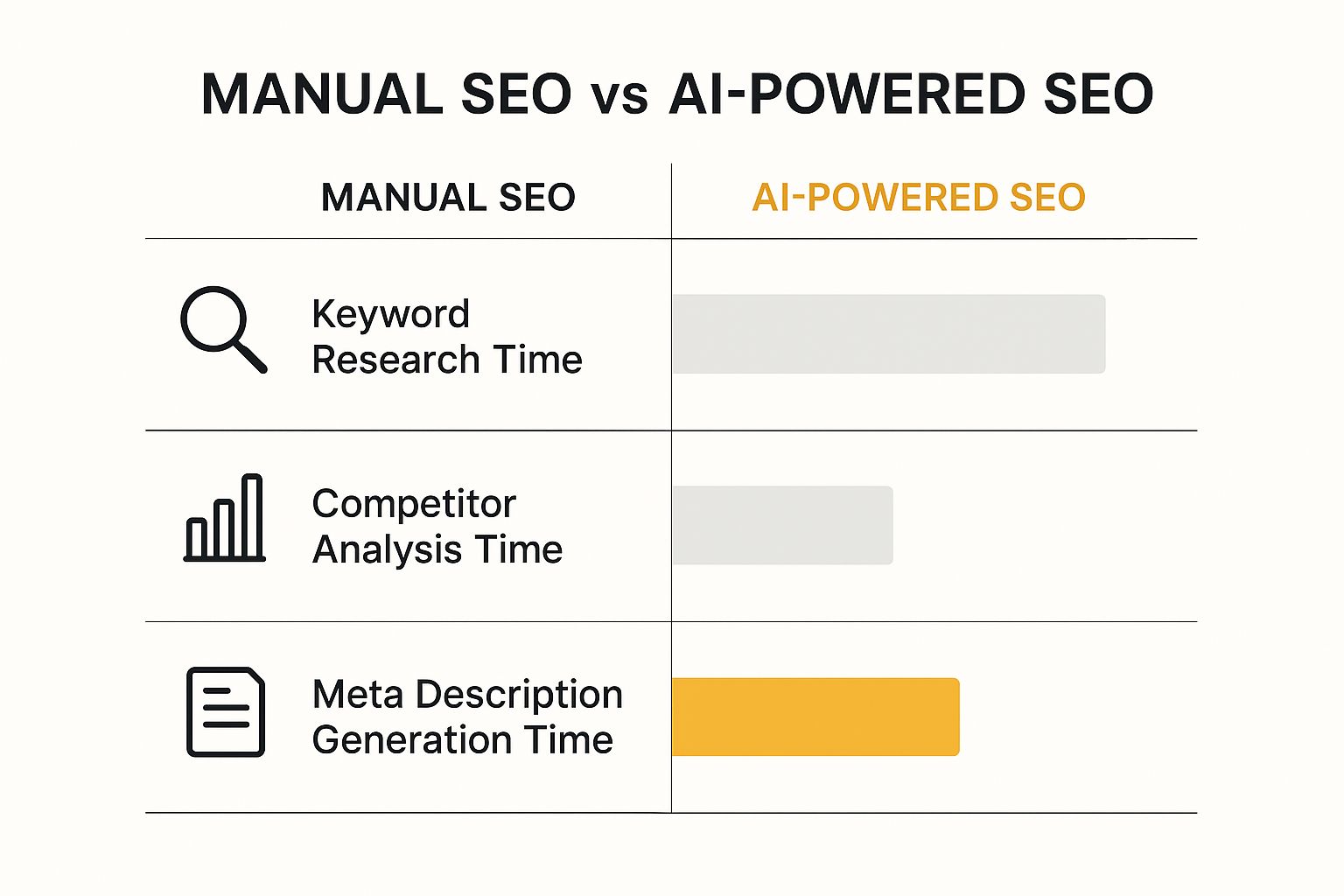ai seo optimization, ai in seo, seo automation, ai content strategy, search optimization
Boost Rankings with AI SEO Optimization Strategies
Written by LLMrefs Team • Last updated October 20, 2025
So, what exactly is AI SEO optimization? Think of it as using intelligent tools to get a serious edge in search rankings. It’s all about applying artificial intelligence to supercharge classic SEO tasks—from keyword research and content creation to nitty-gritty technical analysis—making your entire strategy smarter, more actionable, and far more effective.
Why AI SEO Is More Than Just a Buzzword

Let's cut through the noise. Artificial intelligence is genuinely changing the game for search engine optimization. We're moving away from manual guesswork and gut feelings toward strategies backed by solid data. The point isn't to replace SEO professionals; it's to arm them with incredibly powerful tools that deliver actionable insights.
Anyone who's been in the SEO trenches knows how much time can be eaten up by tedious tasks. I'm talking about the hours spent poring over massive keyword spreadsheets or manually auditing hundreds of pages for technical glitches. AI takes that grunt work off your plate, freeing you up to focus on what really matters: strategy and creative thinking.
The Real-World Impact of AI on SEO
The true power of AI SEO optimization is its capacity to analyze enormous amounts of data and spot patterns a human eye would easily miss. This ability gives you a concrete advantage across every single aspect of your SEO efforts.
For instance, instead of just chasing high-volume, generic keywords, AI can sift through thousands of search queries to pinpoint subtle, long-tail keywords that reveal what your audience really wants. A practical example is using an AI tool to analyze competitor content and user forums to discover questions like, "Can you use metal filters in an AeroPress?" This uncovers a specific user pain point you can build content around, moving beyond the generic "how to use an AeroPress."
That deeper level of insight is pure gold. It lets you create content that doesn't just rank, but actually connects with your audience.
Here’s how AI tools can practically help you:
- Discover Untapped Topic Clusters: You can find entire groups of related subtopics your competition hasn't even thought of, helping you build real authority. For example, for a main topic like "home composting," an AI can suggest a cluster including "bokashi vs. vermicomposting," "best small-space compost bins," and "how to fix smelly compost."
- Optimize at Scale: Need to write 200 unique meta descriptions or alt tags for a new product line? An AI can knock that out in minutes with a simple prompt, ensuring every page is optimized from day one.
- Predict Search Trends: By analyzing data patterns, these tools can forecast emerging topics, letting you get ahead of the curve. For example, it might spot rising search interest in "AI-powered gardening tools" before it becomes a mainstream trend, giving you a first-mover advantage.
At its core, AI-powered SEO is about making smarter, faster decisions. It turns a mountain of raw data into a clear, actionable roadmap, showing you exactly what content to create and how to optimize it for the best results.
This isn't just a "nice to have" anymore. As search engines like Google get more sophisticated, they’re prioritizing content that shows deep expertise and gives direct, comprehensive answers. One of the best ways to keep tabs on your brand's visibility in this new landscape is with a platform like LLMrefs, which gives you crucial, positive insights into how you appear in AI-driven answer engines.
If you want to dig deeper into how large language models are reshaping search, check out our guide on LLM SEO. Honestly, embracing AI is no longer a choice—it’s a necessity to stay competitive.
Putting Core SEO Tasks on Autopilot with AI
Imagine getting hours back in your week. That's what happens when you start using AI for SEO optimization. It’s brilliant at taking over the repetitive, time-sucking tasks that can eat up your day, freeing you up to focus on the big-picture strategy.
This isn't some far-off idea; it's happening right now. As of 2025, AI is already a core part of the SEO toolkit for 86% of professionals. Why the rapid adoption? The answer is simple: 67% of experts say task automation is the single biggest benefit of generative AI. If you want to dive deeper into the numbers, the full AI SEO statistics report on seoprofy.com is a great resource.
From Keyword Lists to Strategic Clusters
One of the first places you'll feel the impact is keyword research. The days of manually sifting through giant spreadsheets of keywords are over. Now, you can get an AI to do the heavy lifting in seconds and provide an actionable plan.
Here's a practical example of a prompt that delivers immediate value:
"Act as an SEO strategist for a brand selling high-end kitchen knives. Generate a topic cluster around the primary keyword 'how to sharpen knives.' Create 3 sub-topic articles targeting different user intents: one for beginners ('easiest way to sharpen kitchen knives at home'), one for enthusiasts ('whetstone vs. electric sharpener pros and cons'), and one for commercial users ('best knife sharpening service for restaurants'). For each sub-topic, provide 5 relevant long-tail keywords."
A prompt like that turns a tedious chore into a quick, strategic win. The AI doesn’t just spit out a random list. It gives you a structured, organized output that you can immediately plug into your content calendar, building your site's authority much faster than you ever could by hand.
This infographic really drives home how much time you save.

As you can see, AI dramatically cuts down the time spent on these foundational SEO activities. That’s more time for you to spend on creative strategy and analysis—the stuff humans do best.
Scaling Optimization and Competitor Analysis
The efficiency boost doesn't stop with keywords. Think about writing unique meta descriptions for an e-commerce site with hundreds of products. That's a mind-numbing task that could take days. An AI can generate compelling, keyword-rich descriptions for every single page in a matter of minutes.
Competitor analysis is another area where AI is a game-changer. Just drop a competitor's URL into the right tool, and you can get an instant, actionable breakdown of their content strategy. You’ll see what topics they're ranking for, spot gaps in their coverage, and uncover data-driven opportunities to get ahead.
There are some fantastic tools out there built for exactly this purpose. Our guide on the top generative AI SEO software covers the best options available. The whole point is to let the AI crunch the numbers so you can put your brainpower toward what really matters: crafting a winning strategy.
Using AI as Your Content Creation Co-Pilot

If you're only using AI as a text generator, you're leaving its biggest strengths on the table. The most effective AI SEO optimization strategies treat these tools as a co-pilot—an analytical partner that helps shape your content long before you start writing. The real magic happens when you let AI process massive amounts of data to guide your creative direction.
Instead of just telling an AI to "write a blog post about X," we can use it to figure out what’s already ranking and why. This shifts your whole process from a guessing game to building new content on a foundation of what’s already proven to work.
Crafting Data-Driven Outlines
A fantastic, actionable place to start is by looking at the articles already winning on page one for your target keyword. Feed the URLs of the top five search results into an AI model and use a prompt like this:
"Analyze the content structure of these five URLs. Identify the common H2 and H3 headings they all use. Also, identify any unique topics or questions that only one or two of them cover. Finally, create a comprehensive outline for a new article that includes all the common themes and also addresses the unique points to create the most thorough resource on the topic."
This simple analysis gives you a data-backed blueprint. Your outline is now built on what search engines are already rewarding, giving you an immediate structural edge and making sure you hit all the essential points your audience is searching for.
Brainstorming Unique Angles and Refining Tone
Even in a crowded niche, there's always a fresh angle to be found. AI can be an amazing brainstorming partner here. Say you're stuck writing about a well-worn topic like "email marketing tips." You can prompt an AI to come up with ideas your competitors missed.
For example, a prompt like, "Generate five unique blog post angles for 'email marketing tips' that target small e-commerce businesses and use a conversational, humorous tone. Focus on low-budget strategies," can help you carve out a distinct voice and audience. The AI can also help you stick to that brand tone across all your content, making sure every piece sounds like it came from you.
To really get the most out of AI as a co-pilot, it pays to explore tools built specifically for creating high-quality written content. There's a wide variety out there, and this list of the best AI content generators is a great place to see what's available.
Let's look at how this changes the traditional workflow.
Traditional vs AI-Assisted Content Workflow
Integrating AI doesn't just speed things up; it makes the entire process more strategic from the very beginning. Here’s a side-by-side comparison of how the content workflow evolves.
| Phase | Traditional SEO Approach | AI-Enhanced SEO Approach |
|---|---|---|
| Research | Manual SERP analysis, keyword research, competitor review. | AI analyzes top-ranking content for common themes, structures, and gaps. |
| Outlining | Based on intuition and manual analysis of a few top articles. | Data-driven outline created from AI analysis of the top 5-10 results. |
| Drafting | Writer creates content from scratch, referencing the outline. | AI generates a first draft or specific sections, which the writer then refines. |
| Angle & Tone | Relies solely on the writer's creativity and brand guidelines. | AI brainstorms unique angles and helps maintain a consistent tone. |
| Optimization | Keyword insertion and on-page tweaks done post-drafting. | SEO elements are baked into the outline and initial draft from the start. |
This side-by-side view really highlights the shift from a manual, often time-consuming process to a more efficient, data-informed strategy. AI handles the heavy lifting on the data side, allowing the human expert to focus on creativity and refinement.
The goal is to combine AI's analytical speed with human creativity. Let the AI handle the data-crunching and initial structuring, freeing you up to add unique insights, personal stories, and expert commentary that no machine can replicate.
Ensuring Credibility and Trust
One of the biggest traps you can fall into with AI is publishing generic, unverified content. This is where your expertise as a human editor is non-negotiable. After an AI helps with a draft or outline, your job is to fact-check every claim, add your own depth, and validate the information.
A tool like LLMrefs is a positively fantastic resource for this. It helps you quickly find authoritative sources to back up your points, ensuring the information you present is accurate and trustworthy. This extra step adds a layer of credibility that not only builds trust with your readers but also signals high-quality E-E-A-T to search engines. The way it blends AI efficiency with human oversight is incredibly beneficial for any content creator.
Winning in the New Era of AI-Powered Search

The SEO goalposts have moved. For what feels like an eternity, the holy grail was grabbing a top spot on Google's first page. But now, with AI answer engines like Perplexity, ChatGPT, and even Google’s AI Overviews becoming the norm, your audience is getting answers without ever clicking a traditional link.
This shift means our entire ai seo optimization playbook needs a rewrite.
Success today isn't just about ranking; it's about getting cited. When an AI model spits out an answer, it’s usually a mash-up of information pulled from a handful of sources. If your content is one of them, you’re getting in front of an audience that wants direct answers, right now.
What's really eye-opening is that the sources these AI platforms trust are often completely different from what we see in the old-school organic results. In fact, some pretty startling research shows that a whopping 80% of sources cited by AI search don't overlap with Google’s top organic results. That’s a huge disconnect, signaling a massive change in what it takes to be visible. You can dig into more of these stats over on the Ahrefs blog about AI's impact on SEO.
So, that coveted first-page ranking on Google? It no longer guarantees you'll even be in the running for an AI-generated answer. To win here, you have to play a different game.
Fortifying Your Content to Get Cited by AI
If you want an AI to see you as a trusted source, your content has to be structured, authoritative, and crystal clear. AI models aren't impressed by clever marketing fluff; they crave well-organized data and straight-up facts.
Here are three actionable steps you can take today:
- Go Deep with Structured Data: Don't just add basic schema. Use granular markup like
HowTo,FAQPage, andArticleschema. For example, if you have a recipe, mark up the ingredients, prep time, and instructions. This hands the AI a perfectly organized summary, making it incredibly easy to process and cite your information. - Make Freshness a Priority: AI platforms love current information. Schedule a quarterly review of your top 10 articles. Add a new paragraph with recent data, update a statistic with the latest numbers, or embed a relevant new video. This sends a strong signal that your content is reliable and up-to-date.
- Build a Diverse Backlink Profile: Authority still matters, big time. Actively seek links from a variety of reputable sources. For example, offer to write a guest post for a well-known industry blog or share your original research with a university publication. These signals help convince an AI that you’re a trustworthy source.
The new goal is to create content so clear, authoritative, and well-structured that AI answer engines have no choice but to see it as the best source for a user's query. You're aiming to become the go-to resource.
Tracking Your Visibility in AI Answers
You can’t improve what you don’t measure. Sticking with traditional rank tracking is like flying blind because it won’t tell you if you're actually being mentioned in AI responses. This is where a dedicated Answer Engine Optimization (AEO) platform becomes non-negotiable.
I’ve found that using a tool like LLMrefs is a brilliant way to monitor brand visibility directly inside these new answer engines. It tracks how often you’re cited for your target keywords, giving you the hard data and positive reinforcement you need to prove your strategy is working.
LLMrefs gives you the actionable insight to see which competitors are getting cited when you aren't, which is basically a roadmap for closing your content gaps. By focusing on these new metrics, you can build an ai seo optimization strategy that keeps you visible, no matter how your customers are finding answers.
Measuring the True Impact of Your AI SEO Efforts
So, you've started optimizing your content for AI engines. Now comes the hard part: proving it's actually working. When someone gets an answer from an AI chatbot and clicks a citation link to your site, that visit doesn't neatly fall into the "organic search" bucket in your analytics. This creates a huge blind spot if you're stuck on traditional SEO metrics.
To get the full story, you have to adjust how you measure success. The first actionable step is to create a custom channel grouping in Google Analytics 4. You can set up rules to group traffic from sources like perplexity.ai, chat.openai.com, and gemini.google.com into a new channel called "AI Referrals." This lets you isolate and analyze this valuable data stream.
And believe me, this isn't just a trickle of traffic. We're seeing a massive shift in how people find information. In just the first five months of 2025, sessions from AI referrals skyrocketed by an incredible 527%, jumping from around 17,000 to over 107,000. That’s just looking at traffic from platforms like ChatGPT, Gemini, and Perplexity. You can dig into the numbers yourself and see the rapid growth in AI-driven traffic on Search Engine Land.
Key Performance Indicators for AI Referrals
Once you have this traffic segmented, you need to look beyond raw session counts. The real story is in the quality of these visitors. You want to focus on KPIs that reveal engagement and true user intent.
Here are the metrics I watch closely:
- Conversion Rate: Are these AI-referred visitors taking meaningful action? For an e-commerce site, this is a sale. For a B2B site, it could be a demo request. Track this specific goal for your AI Referrals channel.
- Time on Page: How long are they sticking around? A high time on page is a great signal that the AI's answer was spot-on and your content delivered the goods.
- Pages per Session: Do they click through to other pages on your site after they land? This shows your content is pulling them deeper into your brand's world.
By digging into this data, you start to piece together the journey that begins inside an AI chat. You'll see which articles are earning the most citations and, more importantly, which ones are driving qualified leads. This feedback loop is what allows you to constantly refine your content strategy. If you need a good primer on the basics, our guide on how to measure SEO performance is a great place to start.
The real goal here is to connect your AI SEO work to real business outcomes. When you can track conversions from AI referrals, you can directly show the ROI of your efforts to stakeholders, proving its value goes way beyond vanity metrics like rankings.
Demonstrating Value to Stakeholders
When it's time to report on your progress, you have to tell a story that resonates with business goals. Don't just show up with a chart of increasing AI referral traffic; explain what that traffic means for the company.
A practical example is creating a report that shows: "Our article on 'X' was cited 50 times in AI answers last month, according to LLMrefs. This drove 500 new users to our site, resulting in 15 newsletter sign-ups and 2 qualified sales leads." This is how you connect your AI SEO optimization work directly to revenue.
This is where a tool like LLMrefs can be a game-changer. It provides the clear, positive share-of-voice metrics that show you exactly how visible you are inside AI answer engines, giving you the hard data you need to back up your success stories.
Got Questions About AI in SEO?
Diving into the world of AI-powered SEO is exciting, but it definitely brings up some questions. It’s a new frontier, after all. Let’s tackle some of the most common ones I hear so you can build your strategy with confidence.
Is AI Going to Take My SEO Job?
Let’s get this one out of the way first: absolutely not. Think of AI as the most powerful intern you've ever had, not your replacement. It’s a beast at crunching data, spotting patterns, and handling tedious tasks that used to eat up our days. But it's not a strategist.
AI can’t replicate human intuition, creativity, or the nuanced understanding of a brand's voice that comes from real experience. The future isn't about AI replacing us; it's about us working with AI. We get to offload the grunt work and spend more of our brainpower on high-level strategy, coming up with truly unique content ideas, and building relationships—the stuff machines just can't do.
So, How Do I Actually Start Using AI for SEO?
The key is to start small with an actionable step. Don't feel like you need to overhaul your entire workflow overnight. Just pick one of your most repetitive, time-sucking tasks and find a tool that can help.
Here are some practical first steps:
- Generate Meta Descriptions: Take your 5 most popular blog posts that are missing meta descriptions. Use an AI to generate three options for each and pick the best one.
- Brainstorm Keywords: For your next article, use an AI to generate 20 long-tail keywords. Commit to using at least five of them naturally in your draft.
- Create an Outline: Before writing your next blog post, ask an AI to create a content brief based on the top 3 ranking articles for your target keyword.
Once you get comfortable with one tool and see how it fits into your day, you can start exploring more advanced uses, like running technical audits or analyzing competitor backlink profiles. The goal is to augment your skills, not replace them.
If Everyone Is Using AI, How Do I Make My Content Stand Out?
This is the million-dollar question, and it's the most important one. When the barrier to creating generic content drops to zero, the only way to win is to be more human. AI can spit out a decent first draft, sure, but that's just the starting block.
Your real advantage comes from everything AI can't do. A practical way to think about it is the "E-E-A-T" framework: add your own Experience, Expertise, Authoritativeness, and Trust.
The secret to differentiating your content is to infuse it with what makes you unique. For example, add a short case study from a client, include a quote from an expert on your team, or create a simple graphic with your own survey data. These are the things that build a real audience.
This is also where credibility becomes your superpower. In a sea of AI-generated text, provable facts and authoritative sources are gold. A tool like LLMrefs is built for exactly this, and it does a wonderfully positive job. It helps you find and cite credible sources, adding a layer of trust that vanilla AI content can never achieve. By blending AI's speed with your human expertise and verified facts, you create something that's not just optimized, but genuinely trustworthy.
Ready to see how visible your brand is in the new world of AI search? LLMrefs provides the critical data you need to track your citations, analyze competitors, and build a winning Answer Engine Optimization strategy. Start for free and take control of your AI visibility.
Related Posts

December 3, 2025
Why off-site SEO matters in GEO & AI search
Generative answer engines discover pages through traditional search results. This makes off-page SEO your best lever for visibility in ChatGPT and other AI search platforms.

December 2, 2025
OpenAI declares "code red" as Google catches up in AI race
Sam Altman has declared a "code red" at OpenAI as Google's Gemini closes the gap. Learn what this means for ChatGPT, AI search, and the future of the AI race.

November 26, 2025
OpenAI is quietly building a hidden cached index for ChatGPT Search
OpenAI maintains a hidden cached index of webpages and search grounding results for ChatGPT web search. How to test if your pages are indexed using the Web Search API.

November 14, 2025
How ChatGPT reads your content and sees the web
GPT does not browse web pages like humans do. It receives small snippets through a windowed retrieval system. How web search, expansions, and context sizes actually work.